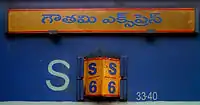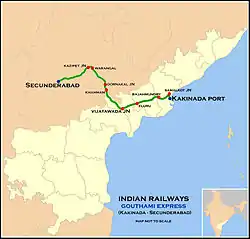Gowthami Express
Gowthami Express is a train running from the port city of Kakinada to Lingampalli.[1] It is named after the River Gowthami, a tributary to the River Godavari. It runs with train numbers as 12737/12738.
 | |||||
 | |||||
| Overview | |||||
|---|---|---|---|---|---|
| Service type | Superfast Express | ||||
| Status | Operating | ||||
| Locale | Telangana, Andhra Pradesh | ||||
| First service | 3-10-1987 | ||||
| Current operator(s) | South Coast Railway zone | ||||
| Route | |||||
| Start | Kakinada | ||||
| Stops | 20 | ||||
| End | Lingampalli | ||||
| Distance travelled | 566 km (352 mi) | ||||
| Average journey time | 10 hours, 15 minutes | ||||
| Service frequency | Daily | ||||
| On-board services | |||||
| Class(es) | Sleeper, Ac 1, 2, 3 General | ||||
| Seating arrangements | Indian Rail standard | ||||
| Catering facilities | Catering available | ||||
| Observation facilities | Large windows in all carriages, cleanliness | ||||
| Baggage facilities | Below the seats | ||||
| Technical | |||||
| Rolling stock | Two | ||||
| Track gauge | Broad (1,676 mm) | ||||
| Electrification | 5,350 hp (3,989 kW) | ||||
| Operating speed | 55 km/h (average) | ||||
| |||||
History
Gowthami superfast Express was introduced on 3/10/1987 and is considered as a sister train to Godavari Express which runs between Visakhapatnam and Hyderabad. It was considered to be one of the most prestigious trains of the South Central Railway (SCR), and connects the Telangana state capital city of Hyderabad with the port city Kakinada
The Gowthami superfast express is considered to be one of the best ways to commute to the state capital, in united Andhra Pradesh, now the capital of Telangana Hyderabad from Delta districts of Andhra Pradesh. People of Kakinada, Rajahmundry, Tadepalligudem, and Eluru prefer the Gowthami Express to travel to Secunderabad. It was upgraded to superfast category in July 2007. It is operated with 12737 / 12738 as train numbers; it used to be 7047 / 7048 prior to being upgraded.
It is one of the longest trains running with 24 coaches and also runs with full capacity throughout the year. Currently, it has two first class cum second class air conditioned coaches, two second class air conditioned coaches, two third class air conditioned coaches, 13 sleeper class, three second class general compartments and two luggage cum brake vans. In total it has six air conditioned coaches. It was the first train in South Central Railway to run with two first class cum second class air conditioned coaches. It has such a huge patronage such that a supplementary train, Cocanada AC Express, a fully air conditioned train, was introduced between Kakinada and Lingampalli in 2012 to cater to the rush. Both these trains run jam packed almost throughout the year.
Gowthami Express is expected to run with 26 coaches very soon, and it will be the first train in SCoR and one among very few in Indian Railways to do so. It is also known for best maintenance of coaches and it was considered as a model rake of South Central Railway, Vijayawada Division (but now it is in SCoR).
Gowthami Express has been diverted from Vijayawada Junction to Rayanapadu railway station bypass[2] from 13 April 2019 to ease bottle necks at Vijayawada Junction. Stoppage at Vijayawada junction has been officially removed from time table of the train.
Loco Links
The train is regularly hauled by a Lalaguda based WAP 7 locomotive from COA. There is no loco reversal, since this train is taking a bypass route near BZA.
Incidents
In July, 2008 Gowthami Express supposedly was short-circuited and fire accident[3] broke out during the night. Those wakened by the sounds escaped by pulling the emergency chain to slow down the train. 40 people died in this incident. It occurred while the train crossed Kesamudram station in Warangal district of Telangana at around 01:07.
References
- "Goutami Express now from Lingampally". Retrieved 10 April 2018.
- Kumar, K. Kalyan Krishna (19 April 2019). "Vijayawada: Travellers pull chain on satellite station plans". Deccan Chronicle. Retrieved 24 May 2019.
- "Gautami Express fire: Warangal district witness to many train accidents". Times of India. 3 August 2008. Retrieved 1 January 2010.
